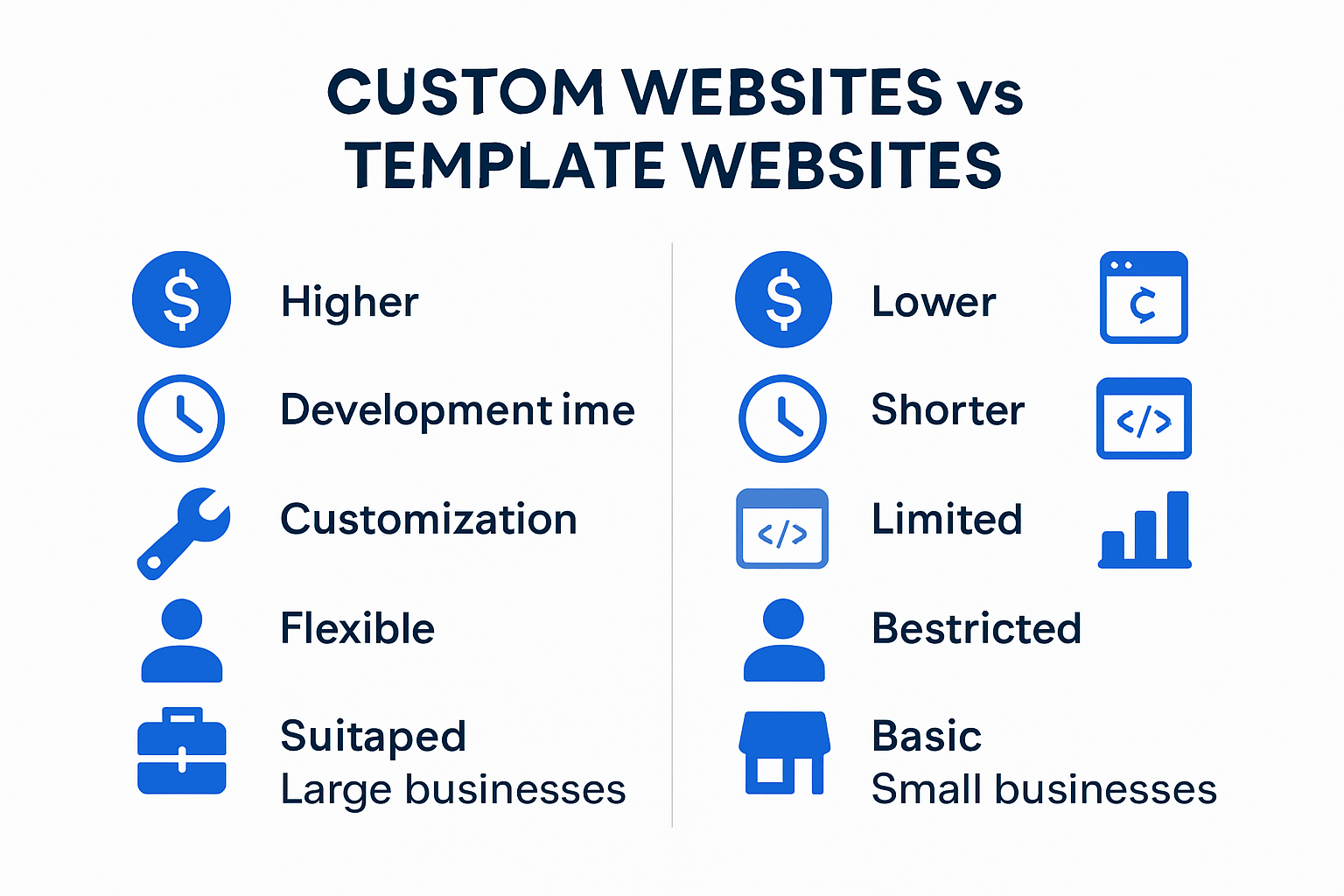Custom vs. Template Websites: Best Choice for Businesses in 2025
Every business faces a big decision when establishing a website: go custom or stick with a ready-made template. Most people assume templates make things easy and cheap, and they are right about one thing. Template websites can cost as little as $200—while a custom site could set you back up to $50,000. Sounds like a no-brainer, right? Not so fast. The real game starts when you look past price tags and realize that this single choice can shape your growth, brand, and even long-term success in ways you might not expect.
Table of Contents
- Understanding Custom And Template Websites
- Comparing Costs And Development Timelines
- Impact On Branding And Growth Potential
- How To Choose For Your Business Needs
Quick Summary
| Takeaway | Explanation |
|---|---|
| Custom websites offer unique branding opportunities | Custom sites allow businesses to create a distinct digital identity that reflects their brand, providing superior control over design and user experience. |
| Template websites are cost-effective for rapid deployment | Template solutions significantly lower initial investment costs and enable businesses to establish an online presence quickly, making them ideal for startups. |
| Long-term scalability favors custom websites | Custom websites offer better flexibility for growth and can be more easily adapted to integrate new technologies and features as business needs evolve. |
| Technical complexity varies significantly | Custom websites require advanced development skills and are more complex, while template websites need minimal technical expertise for setup and use. |
| Evaluate financial and resource needs carefully | Choosing between custom and template websites should involve a thorough analysis of budget constraints, technical capabilities, and long-term maintenance costs. |
Understanding Custom and Template Websites
The digital world presents businesses with a critical decision when establishing their online presence: choosing between custom websites and template-based solutions. This choice significantly impacts a company’s digital strategy, brand representation, and overall online effectiveness.
The Core Differences in Website Development
At the heart of the custom vs. template websites debate lies a fundamental distinction in approach. Custom websites are unique digital platforms built from scratch, specifically tailored to a business’s exact requirements and brand identity. According to Search Engine Journal , these websites offer unparalleled flexibility and can be precisely engineered to meet complex business needs.
In contrast, template websites provide pre-designed frameworks that businesses can quickly adapt with minimal technical expertise. Smart Bug Media highlights that these solutions offer a faster and more cost-effective route to establishing an online presence, making them attractive for businesses with limited resources or technical skills.

Strategic Considerations for Website Selection
Choosing between custom and template websites involves evaluating multiple critical factors. Businesses must consider their unique requirements, budget constraints, technical capabilities, and long-term digital strategy. A custom website provides maximum control and can be precisely aligned with specific brand objectives, while template websites offer rapid deployment and lower initial investment.
Key Evaluation Points :
- Uniqueness : Custom websites guarantee a distinctive digital identity
- Scalability : Custom solutions offer more robust growth potential
- Budget : Template websites significantly reduce initial development costs
- Technical Complexity : Custom sites require more advanced development skills
Design Hill emphasizes that the decision should not be viewed as binary but as a strategic choice aligned with specific business goals. Some organizations might benefit from a hybrid approach, starting with a template and gradually transitioning to a more customized solution as their digital needs evolve.
Understanding these nuanced differences empowers businesses to make informed decisions about their digital strategy. Whether prioritizing unique brand representation or seeking rapid online establishment, the right website approach can significantly impact digital success.
Comparing Costs and Development Timelines
Business leaders face complex financial and time-management considerations when selecting between custom and template websites. Understanding the nuanced cost structures and development timelines becomes crucial for making an informed strategic decision.
Initial Investment and Long-Term Financial Implications
Custom websites represent a significant upfront investment. Super.so reveals that initial development costs can range from $5,000 to $50,000, depending on complexity and specific business requirements. These expenses cover comprehensive design, unique functionality, and tailored user experiences.
In contrast, template websites offer a more budget-friendly approach. Squareko indicates that template solutions can be launched for as little as $200-$3,000, making them attractive for startups and small businesses with limited financial resources.
Here is a table comparing the costs and timelines of custom and template websites for quick reference.
| Website Type | Initial Cost Range | Typical Launch Time | Technical Expertise Needed |
|---|---|---|---|
| Custom Website | $5,000 – $50,000 | 3 – 6 months | Advanced |
| Template Website | $200 – $3,000 | Days to weeks | Minimal |
Development Timeline and Complexity
Time-to-market is another critical factor in the website development decision. Custom websites typically require 3-6 months for complete development, involving multiple stages:
- Design conceptualization
- Technical architecture planning
- Custom feature development
- Rigorous testing and optimization
Template websites dramatically reduce development timelines. Social Nomics notes that businesses can launch template-based websites within days or weeks, providing immediate online presence with minimal technical overhead.
Total Cost of Ownership and Scalability

Beyond initial development, businesses must consider long-term financial implications. Custom websites, while expensive initially, offer more flexible scalability and lower maintenance costs over time. Template websites might incur recurring expenses through:
- Mandatory plugin updates
- Limited customization requirements
- Potential platform migration costs
Careful evaluation of these factors helps businesses align their digital strategy with financial capabilities, ensuring sustainable online growth and optimal resource allocation.
Impact on Branding and Growth Potential
A website serves as more than just a digital platform. It represents a brand’s digital identity, strategic communication tool, and critical growth mechanism. The choice between custom and template websites profoundly influences a company’s ability to establish a distinctive online presence and expand its market reach.
Unique Brand Expression and Visual Identity
Search Engine Journal emphasizes that custom websites allow businesses to create a truly unique digital representation. Unlike template solutions, custom designs enable organizations to craft pixel-perfect visual experiences that authentically reflect their brand’s personality, values, and strategic positioning.
Brand Differentiation Strategies :
- Color Palette Customization : Precise color matching to brand guidelines
- Typography Control : Using exact brand fonts and typographic hierarchies
- Interaction Design : Creating unique user experience elements
Scalability and Future-Proofing Digital Strategy
Research Gate highlights that custom websites provide unparalleled flexibility for business growth. These platforms can be systematically expanded, integrated with emerging technologies, and adapted to changing market demands without fundamental architectural limitations.
Template websites often restrict growth potential through:
- Rigid Design Frameworks
- Limited Customization Options
- Performance Bottlenecks
To help visualize how website development choices influence long-term strategy, here’s a table outlining branding, scalability, and competitive positioning for both approaches.
| Dimension | Custom Website | Template Website |
|---|---|---|
| Brand Expression | Unique, fully tailored | Limited customization |
| Scalability | High, easily adaptable for growth | Restricted by platform/template limits |
| Competitive Positioning | Strong, signals professionalism | Modest, may appear generic |
| Market Perception | High-end, establishes credibility | Budget-focused, possibly less distinctive |
Competitive Positioning and Market Perception
Spinx Digital reveals that a meticulously crafted website significantly influences market perception. Custom websites communicate professionalism, technological sophistication, and commitment to exceptional user experiences.
Businesses utilizing custom websites signal to potential clients their willingness to invest in high-quality digital infrastructure. This strategic approach builds credibility, distinguishes the brand from competitors, and creates a powerful first impression in an increasingly digital marketplace.
Ultimately, the website represents more than a digital brochure. It is a dynamic platform for brand storytelling, customer engagement, and strategic growth. Choosing the right development approach becomes a critical decision that extends far beyond initial design considerations.
How to Choose for Your Business Needs
Selecting the right website approach requires a strategic assessment of your business’s unique requirements, growth trajectory, and digital objectives. Understanding the nuanced differences between custom and template websites enables informed decision-making that aligns with your organizational goals.
Assessing Business Complexity and Functionality Requirements
Search Engine Journal highlights that businesses must carefully evaluate their specific customization needs. Complex businesses with unique operational models and specialized functionality will benefit significantly from custom websites. These platforms offer extensive personalization capabilities that template solutions cannot match.
Key Assessment Criteria :
- Unique Business Processes : Requires specialized feature integrations
- Complex User Interactions : Need for advanced user experience design
- Specific Performance Requirements : Demanding technical specifications
Startups and small businesses with straightforward digital requirements might find template websites more suitable. These platforms provide quick deployment and basic functionality at a lower initial investment.
Evaluating Scalability and Future Growth Potential
Research Gate emphasizes the importance of long-term digital strategy. Custom websites offer superior scalability, allowing businesses to adapt and expand their digital infrastructure seamlessly.
Consider these growth-related factors:
- Anticipated Business Expansion : Potential for market diversification
- Technology Integration : Ability to incorporate emerging digital tools
- Performance Optimization : Capacity for continuous technical enhancement
Financial and Resource Considerations
Digital Silk recommends a comprehensive evaluation of financial resources and technical capabilities. The decision between custom and template websites extends beyond immediate costs, encompassing long-term investment and organizational readiness.
Decision Framework :
- Budget Constraints : Initial and ongoing development costs
- Technical Expertise : In-house development capabilities
- Maintenance Requirements : Long-term support and updates
Businesses should conduct a thorough cost-benefit analysis, considering not just monetary investment but also potential returns, brand positioning, and competitive advantage. The right website strategy serves as a powerful digital foundation that supports business growth and enhances market presence.
Ultimately, there is no universal solution. The optimal approach depends on a holistic understanding of your business’s unique digital ecosystem, strategic objectives, and resource capabilities.
Frequently Asked Questions
What are the main differences between custom and template websites?
Custom websites are built from scratch to meet specific business needs, offering unique branding and features. Template websites, on the other hand, are pre-designed frameworks that are easier and faster to set up but offer limited customization.
How much does it cost to develop a custom website compared to a template website?
A custom website can cost between $5,000 to $50,000, while template websites typically range from $200 to $3,000, making templates a more budget-friendly option for startups.
Which type of website is better for SEO and branding?
Custom websites are generally better for SEO and branding because they allow for unique design and functionality, which can enhance user experience and search engine visibility. Template websites may lead to generic designs that are less effective for branding.
How long does it take to launch a custom website versus a template website?
Custom websites usually take 3 to 6 months to develop due to their complexity, while template websites can be launched within days or weeks, providing a quicker online presence.
Ready to Build a Website That Actually Fuels Your Growth?
You have just learned how choosing between a custom and a template website can define your brand’s future. The risk of blending into the crowd with a generic template or struggling with technical limitations is real. If you are aiming for a unique identity, scalability, and a website that matches your big ambitions, you need a team that understands what drives digital success in 2025. TRAVLRD is built for businesses like yours that want modern, conversion-driven digital solutions—backed up by proven expertise, creativity, and a client-first approach.

Take the next step toward real online impact. We invite you to get a free consultation right now. Discover how our custom website development can make your digital presence stand out and support your long-term goals. Explore our portfolio, see client success stories, and see why forward-thinking companies trust TRAVLRD for high-end web solutions. Do not let your competition pull ahead while you wait— connect with our team and start building your advantage today.







